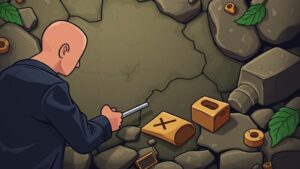Detecting for Hidden Silver Hoards in Deserted Caravan Stops
Detecting for Hidden Silver Hoards in Deserted Caravan Stops
The search for hidden silver hoards in deserted caravan stops is a fascinating intersection of archaeology, history, and treasure hunting. These locations were once bustling hubs of trade in regions such as the Silk Road and the trans-Saharan routes, where merchants transported goods across vast landscapes. Understanding the characteristics of these caravan stops and employing modern detection methods can significantly enhance the chances of uncovering historical treasures.
Historical Context of Caravan Stops
Caravan stops, often referred to as caravanserais, played a pivotal role in facilitating trade and providing refuge for merchants and their camels. Typically located at strategic intervals along trade routes, these stops featured amenities such as water, food, and lodging. The economic significance of caravan stops became pronounced during medieval times, particularly between the 8th and 15th centuries, when silver and other precious metals flowed between different cultures.
- Caravanserais in the Middle East facilitated trade across continents.
- Silver coins often circulated among merchants and were sometimes buried for safekeeping.
Many hoards are believed to have been hidden due to the instability of the times, including conflicts, banditry, or sudden departure during trading activities. Understanding the socio-political context can provide crucial clues in locating these hidden treasures.
Characteristics of Deserted Caravan Stops
Recognizing the features of deserted caravan stops is essential for prospective treasure hunters. Key characteristics include:
- Proximity to Water Sources: Most caravan stops were situated near rivers or springs to provide water for travelers and animals.
- Abandoned Structures: Remnants of buildings, walls, or other constructions can indicate the remains of a caravanserai.
- Artifacts: Excavations may reveal artifacts such as pottery shards, tools, and, occasionally, coins.
Modern archaeology has brought to light numerous examples of these caravan stops; for example, the caravanserai at Kizkalesi in Turkey showcases well-preserved ruins that acted as a resting place for traders hundreds of years ago. Such locations offer a blueprint to identify other deserted stops along historical routes.
Detection Methods and Technologies
Advancements in technology have significantly changed how hidden silver hoards can be detected at these historical caravan stops. Several methods and tools are employed:
- Metal Detectors: The most commonly used tools, sensitive enough to detect small silver coins buried beneath the surface.
- Ground Penetrating Radar (GPR): A non-invasive technique that helps locate buried structures or anomalies, proving effective for larger hoards.
- Geophysical Surveys: Techniques such as resistivity and conductivity measurements can indicate buried artifacts by analyzing soil composition.
A real-world application of these technologies can be observed in the archaeological explorations at the site of the ancient Persian city of Çatalhöyük, where metal detectors and GPR systems have revealed hidden structures and artifacts, leading to significant discoveries.
Case Studies: Success Stories in Treasure Hunting
Numerous successful treasure hunts illustrate the effectiveness of modern detection methods at caravan stops. One notable case took place in 2017 when amateur archaeologists discovered a hidden cache of silver coins near a deserted caravan stop in the Iranian plateau. Utilizing both metal detectors and GPR, they uncovered over 500 silver coins dating back to the Safavid dynasty.
Another significant instance occurred in Yemen, where researchers utilized GPR technology in a historic caravanserai site, uncovering buried walls and significant artifacts that provided valuable insights into the trade practices of the time.
Ethical Considerations and Legal Framework
The pursuit of hidden treasures, particularly in historically sensitive regions, raises ethical considerations. It is crucial to understand local laws concerning treasure hunting, which vary significantly between regions. Many countries require permits for metal detecting and archaeological excavations, especially on lands of cultural significance.
- Respecting Cultural Heritage: It is vital to engage with local communities and authorities to ensure that the search does not disturb important archaeological resources.
- Legal Obligations: Understanding and adhering to laws protects not only the artifacts but also the integrity of the historical narrative.
In Australia, for instance, specific legislative frameworks govern the discovery of artifacts, underscoring the importance of responsible treasure hunting.
Actionable Takeaways
For those interested in searching for hidden silver hoards at deserted caravan stops, several steps can enhance their chances of success:
- Conduct thorough historical research to identify potential caravan stop locations.
- Use modern detection technologies, such as metal detectors and GPR, to enhance search accuracy.
- Abide by local laws and engage with communities to ensure ethical practices.
The allure of discovering hidden treasures within deserted caravan stops intertwines history, technology, and adventure. With diligent research and appropriate methodologies, treasure hunters can reconnect with the past and potentially uncover remnants of a vibrant trading world.


